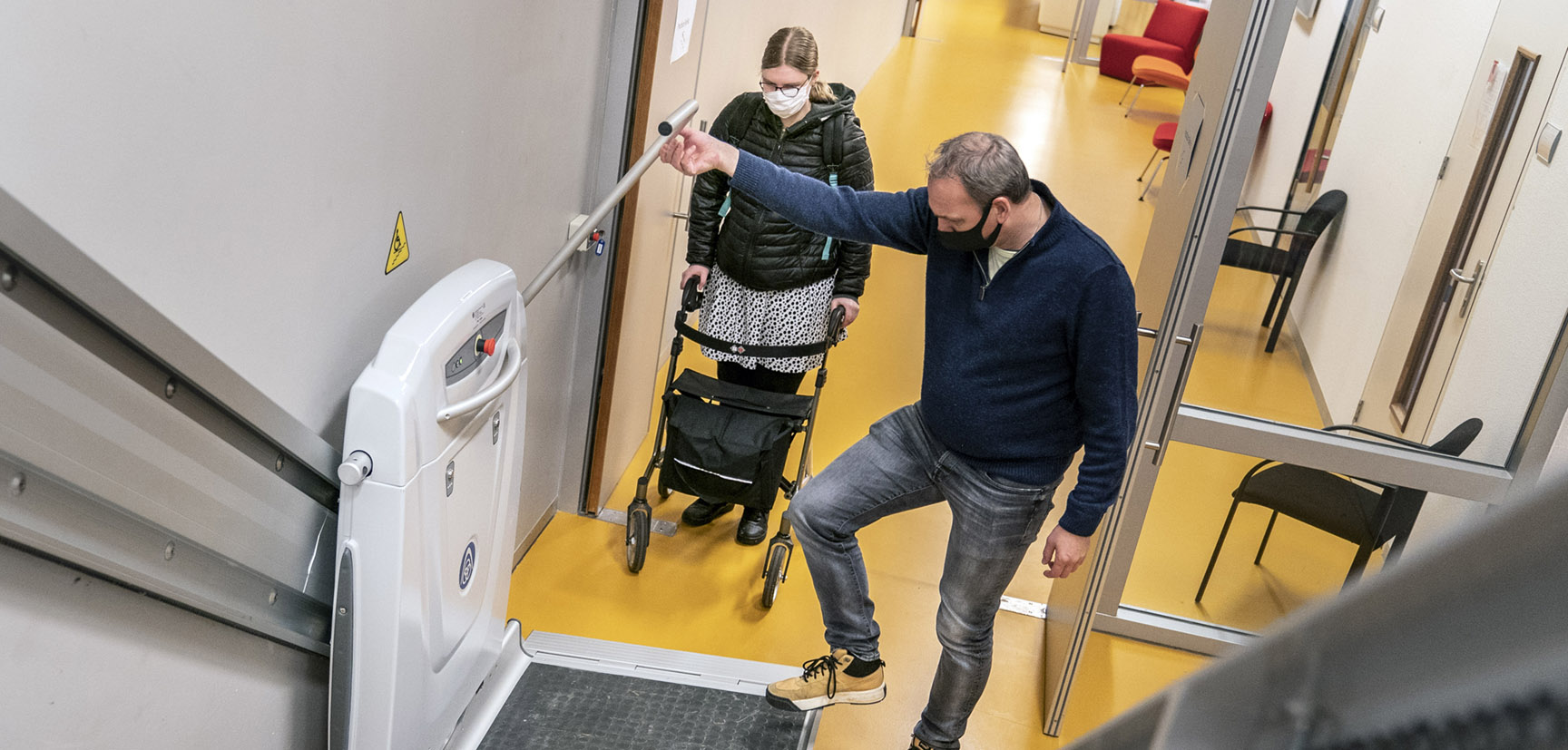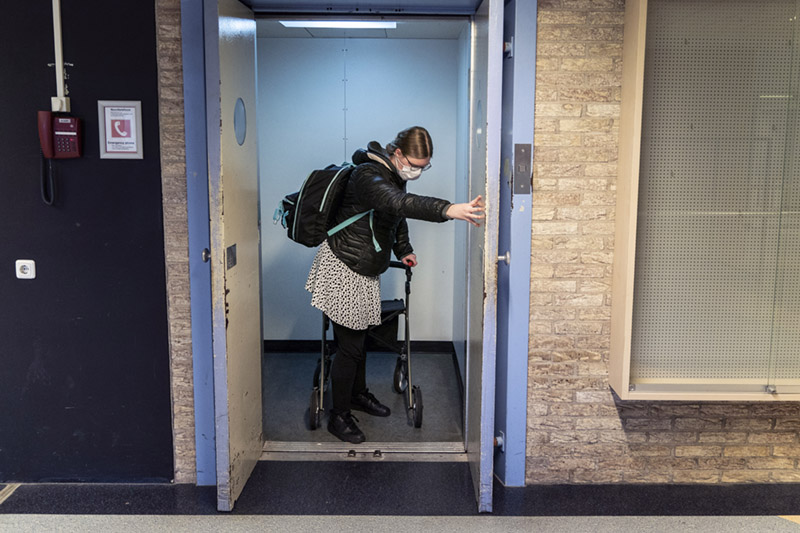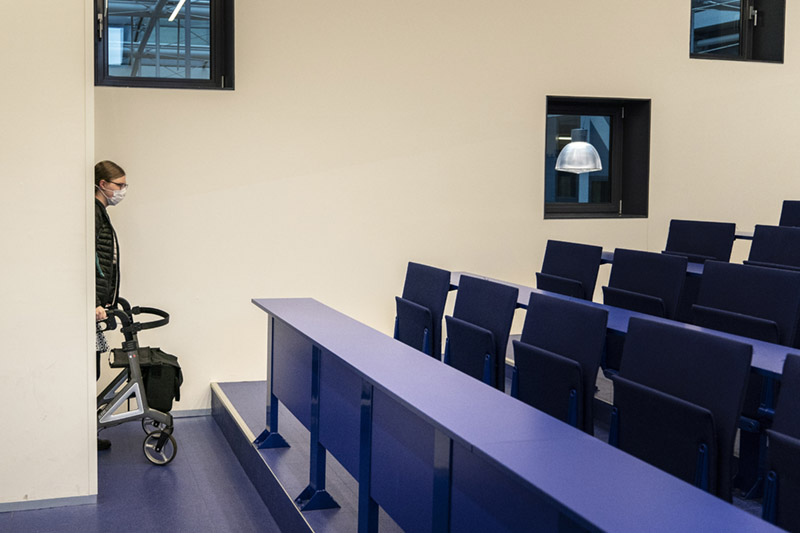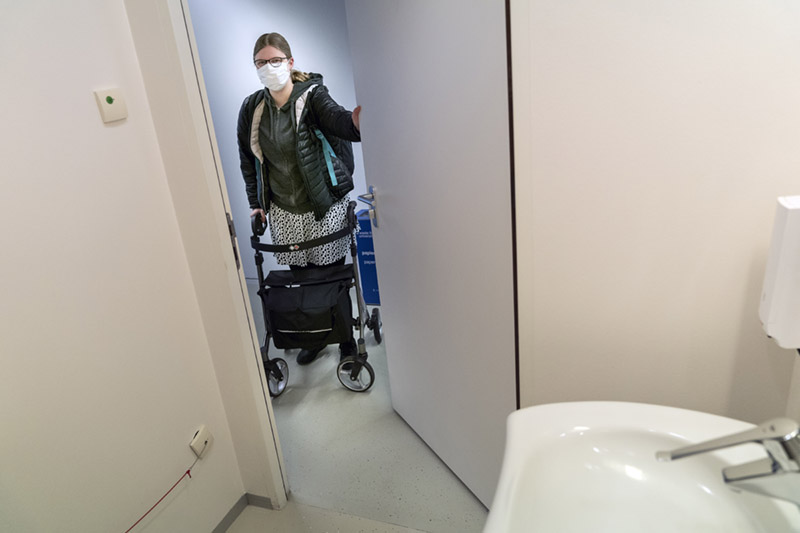
When will the UG become truly accessible?
Obstacle course on the way to class
Obviously, it’s great that the Bernoulliborg has a bathroom for people with disabilities where students who depend on a wheelchair or a walker have enough room to move around.
Too bad the door is so heavy that it falls shut again as soon as you push it open, making it difficult to actually get into the room.
‘In other buildings, the door stays open occasionally, but I guess no one thought about that when designing this bathroom’, says first-year mathematics student Jard Nijholt. She sways as she tries to hold open the door with one hand and manoeuvre her walker inside with the other.
Obstacles
The bathroom isn’t the only difficulty at the Bernoulliborg. Jard’s next obstacle is entering the classroom. She manages the first, once again heavy, door relatively fine. But then there’s a second door. And she absolutely can’t get through it.
I’ve become pretty good at finding solutions
A bystander sees her struggling and opens the door for her. All well and good of course, but she’d rather have done it herself. ‘Improved accessibility would make my life a lot easier.’
Once in the room, there’s one more obstacle to face. The first row of seats is on a raised platform. She manages to climb onto the corner of the platform, but only just. ‘This is how the whole world’s been designed, so I’ve become pretty good at coming up with solutions.’
Demands
Every day, Jard is confronted with the fact that the university isn’t as accessible as it should be. Five years ago, government buildings were mandated to become more accessible to people with disabilities. In 2018, the UG devised a policy to improve the situation.
The policy stated that the university would create a committee and a central contact point. The university would also discuss making changes to old buildings with the city. That committee exists, but there’s no sign of a contact point.
Last year, the Implementation Plan on Disabled Students committee wrote an action plan and submitted a list of demands to the board of directors. ‘There is a legal framework, of course, but sometimes that isn’t enough’, says committee chair Aletta Westra. ‘There are still things that aren’t working as they should.’

Stressful
Jard knows all about that. She ran into problems her very first day at the Zernike campus. She had class at the Linneausborg, a relatively modern building. She had to go to the basement, but she couldn’t find an elevator anywhere. When she finally did, she still had to go up two sets of stairs just to get there.
Getting the elevator key from reception took fifteen minutes. Back at the stair lifts, she discovered they were out of order. ‘My TA stepped in and quickly found us all a different classroom’, she says. ‘But the whole thing was really stressful. I didn’t know anyone yet and the fact that I couldn’t help it only made it worse.’
Karien van Wieren, who’s dependent on a wheelchair, has also noticed the university isn’t nearly as accessible as it should be. During a recent visit to the UMCG, the clinical psychology student was confronted with a wheelchair ramp that was so steep she couldn’t ascend it. ‘There was no way I would have made it up there. Things like that need to be better.’
Finding accommodations
Heavy doors, elevators that are out of service, and ramps aren’t even the biggest issue, says Karien, who also works as project support at Wiel&Deal, an organisation that advocates for students with disabilities. ‘Finding the accommodations that do exist can be hard.’
People use the accessible bathroom as storage
Wiel&Deal receives a lot of complaints from students with disabilities who are unable to find wheelchair access, accessible bathrooms, or stair lifts. ‘Whenever I go to a new building, I first have to find out where I can even enter’, says Karien.
Accessible entrances are usually at the back of buildings and need a doorman to open them. ‘But they’re often absent.’
Excluded
Signs to bathrooms and elevators are often hard to find or missing altogether. ‘You develop a knack for finding them’, says Jard. ‘New buildings are still stressful though, because you’re never sure if you’ll be able to get where you need to be.’

A few days ago, she had a class in the Energy Academy for the first time. It’s the university’s most recent building. Once again, she ran into issues. ‘If the building had an accessible entrance, I couldn’t find it.’
It’s small things like these that make students feel even more excluded from society, an issue they already face because of their disability. ‘Always having to use a different entrance reinforces the feeling of being different’, says Karien.
Empathy
On top of that, ‘normal’ people don’t seem to understand what she and other people like her have to deal with. She regularly encounters accessible bathrooms that are full of cleaning supplies. ‘Because they’re used so little, people think they can use them as storage.’
People with disabilities were also told for years that online education was impossible. But then the pandemic started. ‘The fact that online education was suddenly feasible was pretty hurtful.’
It was hurtful that the pandemic suddenly did make online classes possible
Architects and engineers are also lacking empathy, it seems. Accessibility is rarely considered in the design stage. ‘Some architects might think they’re making a building accessible, when in reality they’re not.’
Even when something’s been designed with people in wheelchairs in mind, architects forget other things. ‘Some people are blind, or deaf, or have autism. They need accommodations, too.’
Her advice would be to involve more people with disabilities in the process. ‘If you don’t have a disability yourself, it’s much harder to imagine what people might need.’
Obstacles
Westra calls on students to report the issues they run into. ‘We really need their help. They know where all the obstacles are. We don’t encounter it ourselves, so we don’t know about it.’
But because there still isn’t a central contact point, all students have to turn to are their study advisers. And because of the pandemic, the committee’s action plan also hasn’t been implemented yet. The university is still looking for two project managers to head up two smaller expert committees, after which they’ll finally make some changes. Hopefully.
Jard, Karien, and all the other students and employees with disabilities will simply have to wait a little longer. Jard has resigned herself to the situation. ‘Getting upset about it doesn’t get me anywhere. It’s not surprising, though. I’ll just keep finding my own solutions.’
